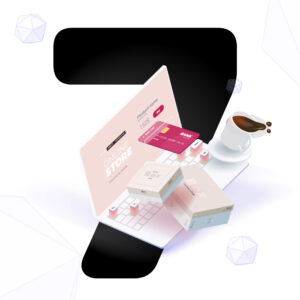
The fashion industry is one of the most dynamic and lucrative sectors in the world. According to Statista, the global market value of fashion was $759.5 billion in 2021, and it is expected to reach $1 trillion by 2026, with a compound annual growth rate (CAGR) of 7.18%. The online segment of fashion has been growing even faster, thanks to the increasing penetration of digital technologies and changing consumer preferences.
However, starting an e-commerce business in fashion is not an easy task. It requires careful planning, market research, product development, branding, marketing, customer service, and more. Moreover, it faces fierce competition from both offline and online players who are constantly innovating and adapting to evolving trends and demands.
In this guide, we will provide you with some tips and best practices on how to start an e-commerce business in fashion successfully. We will cover the following topics:
- How to choose your niche and target market
- How to create your unique value proposition and brand identity
- How to design and develop your e-commerce website
- How to source or manufacture your products
- How to market and promote your e-commerce store
- How to provide excellent customer service and retention
How to choose your niche and target market
Choosing your niche and target market for fashion e-commerce business is a crucial step that can determine your success or failure. A niche is a specialized segment of the market that attracts a specific audience with common interests, problems or needs. A target market is a group of potential customers who are most likely to buy your products. To choose your niche and target market, you need to follow these steps:
- Consider your interests and hobbies. Finding a niche that you are passionate about will make it easier for you to create products, content and marketing campaigns that resonate with your audience.
- Find a problem and provide a unique selling proposition. One way to choose a niche is by thinking about what sets your brand and product apart from the competition. What problem are you solving for your customers? What value are you offering them? How can you communicate this clearly and effectively?
- Analyze the competition. You need to research what other fashion e-commerce businesses are doing in your niche and how they are performing. You can use tools like Google Trends, Keyword Planner, Amazon Best Sellers and social media platforms to find out what products are popular, what keywords are searched for and what content is engaging .
- Determine your market and target audience. You need to define who your ideal customers are based on their demographics, psychographics, behaviors and preferences. You can use tools like Google Analytics, Facebook Insights, surveys and interviews to collect data about your audience .
- Discover trends and research keywords. You need to stay updated on the latest trends in your niche and use relevant keywords in your product titles, descriptions, tags and content. This will help you rank higher on search engines and attract more organic traffic .
By following these steps, you can choose a niche and target market that will help you grow your fashion e-commerce business in 2023.
How to create your unique value proposition and brand identity
Another crucial step in starting an e-commerce business in fashion is to create your unique value proposition (UVP) and brand identity.
A UVP is a statement that summarizes what makes your e-commerce store different from others why customers should buy from you what benefits they will get etc. For example Zappos’ UVP is “Free shipping both ways 365-day return policy 24/7 customer service”
A brand identity is a set of elements that represent your e-commerce store such as name logo slogan color scheme font style tone voice personality values mission vision etc. For example Nike’s brand identity includes its name swoosh logo “Just do it” slogan red white black color scheme bold font style inspirational tone voice athletic personality innovation excellence values empowering mission inspiring vision etc.
Creating a UVP and brand identity is important because it will help you:
- Attract attention interest desire action (AIDA) from potential customers by highlighting what makes you special
- Build trust loyalty advocacy (TLA) from existing customers by delivering what you promise
- Differentiate yourself from competitors by showcasing what makes you better
- Establish recognition awareness reputation (RAR) among potential customers by creating memorable impressions
To create a UVP for your fashion e-commerce business, you need to follow these steps:
- Identify your target market and their pain points. Who are you selling to and what problems are you solving for them?
- Analyze your competitors and their UVPs. What are they offering and how are they positioning themselves in the market?
- Define your unique benefits and advantages. How do you solve your customers’ pain points better than your competitors? What extra value do you provide to enhance their experience?
- Communicate your UVP clearly and concisely. Use simple language that resonates with your target audience. Highlight the main benefits and outcomes of choosing your brand.
For example, if you are selling luxury fashion items online, your UVP could be something like this:
“Shop iconic pieces of style that will never go out of fashion. We offer exclusive collections from top designers, curated by experts who know what suits you best. Enjoy free shipping, returns, and personal styling services with every purchase.”
This UVP addresses the pain points of luxury fashion shoppers who want to stand out from the crowd, have access to high-quality products, and receive personalized attention. It also showcases the unique benefits of shopping online with this brand: convenience, variety, expertise, and customer service.
How to design and develop your e-commerce website
Designing and developing a fashion e-commerce business requires a clear vision, a customer-centric approach, and a competitive edge. A fashion e-commerce business plan should outline the target market, the value proposition, the marketing strategy, the operational model, and the financial projections of the online store. Some of the key factors to consider when designing and developing a fashion e-commerce business are:
- Choosing the best e-commerce platform for online apparel that suits your needs and budget. The platform should be user-friendly, secure, scalable, and customizable.
- Using marketing automation to create an omnichannel customer experience that integrates email, social media, web push notifications, SMS, and other channels.
- Supporting your fashion e-commerce strategy with social media and paid ads that showcase your brand personality, engage your audience, and drive traffic to your site.
- Fine-tuning the technical workings of your online apparel site such as site speed, SEO optimization, mobile responsiveness, product descriptions, images, videos, reviews, etc.
- Offering different payment methods that appeal to a wider audience and increase conversion rates. You should also provide easy and smooth deliveries/returns policies that build trust and loyalty among your customers.
- Leveraging innovative technologies such as AI-powered personalization tools that help you recommend products based on customer preferences, augmented reality that allows customers to try on clothes virtually, or print-on-demand services that enable you to customize products without inventory costs.
By following these tips and best practices for designing and developing a fashion e-commerce website you can create a successful online store that stands out from the crowd and attracts loyal customers.
How to source or manufacture your products
One of the most important decisions for a fashion e-commerce business is how to source or manufacture your products. There are different product sourcing methods that you can choose from, depending on your budget, time frame, and level of customization. Some of the most common product sourcing methods are:
- Dropshipping: This is the easiest and most hands-off way to source products. You partner with a dropshipping supplier who holds and ships the products for you. You only pay for the products when you sell them, so you don’t need to invest in inventory upfront. You can also test different products without risk of losing money. However, dropshipping also has some drawbacks, such as lower profit margins, less control over quality and branding, and potential shipping delays .
- Wholesaling: This is a good product sourcing strategy if you want to get up and running quickly. You buy products in bulk from a wholesaler at a discounted price and then resell them at a higher price. You have more control over pricing, branding, and inventory management than dropshipping. However, wholesaling also requires more capital, storage space, and logistics than dropshipping .
- Manufacturing: This is the most challenging but also the most rewarding way to source products. You create your own custom designs and prototypes and then find a manufacturer who can produce them for you. You have full control over quality, branding, differentiation, and innovation. However, manufacturing also involves more time, money, risk, and complexity than dropshipping or wholesaling .
To choose the best product sourcing method for your fashion e-commerce business, you need to consider your goals, resources, target market, niche, and competitive advantage . You can also use online platforms and apps to find reliable suppliers for each product sourcing method .
How to market and promote your e-commerce store
Marketing and promoting your fashion e-commerce store can be challenging in a competitive and dynamic industry. However, there are some effective strategies that can help you attract and retain customers, increase your sales and grow your brand awareness. Here are some of them:
- Optimize your website for search engines (SEO). This means using relevant keywords, creating high-quality content, improving your site speed and user experience, and building links from other reputable sites. SEO can help you rank higher on Google and other search engines, which can drive more organic traffic to your store.
- Start a blog to improve website traffic and build a community. A blog can showcase your expertise, personality and style, as well as provide useful information and tips for your target audience. You can also use your blog to promote your products, share customer stories, announce new arrivals or discounts, and engage with your readers through comments or social media.
- Support a good cause. Customers today are more conscious about the social and environmental impact of their purchases. By aligning your brand with a cause that resonates with your values and customers’ preferences, you can differentiate yourself from competitors, increase customer loyalty and trust, and generate positive word-of-mouth. For example, you can donate a percentage of your sales to a charity, use eco-friendly materials or packaging, or partner with local communities or organizations.
- Use social media micro-influencers to boost sales. Micro-influencers are people who have a small but loyal following on social media platforms like Instagram or TikTok. They often have high engagement rates and credibility among their followers. By collaborating with micro-influencers who share your niche and aesthetic, you can reach new potential customers who trust their recommendations, increase brand awareness and social proof, and drive more traffic to your store.
- Encourage customers to leave reviews. Reviews are powerful tools to influence customer behavior and decision-making. They can also help you improve your SEO ranking by providing fresh content and keywords for your site. You can incentivize customers to leave reviews by offering discounts, free shipping or loyalty points. You can also display reviews on your product pages or homepage to showcase customer satisfaction and social proof.
- Share your insights and story in online fashion publications. Online fashion publications are platforms where you can reach a wider audience who are interested in fashion trends, news or advice. By contributing guest posts or interviews to these publications, you can establish yourself as an authority in the industry, showcase your unique value proposition and story behind your brand name , and drive more traffic back to
your store. - Incorporate email campaigns for abandoned carts , seasonal products ,and special offers . Email marketing is one of the most effective ways to communicate with your existing customers, remind them of their interest in your products, and encourage them
to complete their purchase . You can also use email campaigns to promote seasonal products , such as winter coats or summer dresses ,or offer special discounts ,
coupons ,or free gifts for loyal customers . Email marketing can help you increase conversions, repeat purchases, and customer retention.
How to provide excellent customer service and retention
Customer service is a crucial factor for customer retention in fashion e-commerce businesses. Customers expect a seamless and personalized experience across all touchpoints, from browsing to purchasing to receiving their orders. They also want to be able to reach out to the brand through their preferred channels and receive prompt and helpful responses.
According to a PwC study, more than 50% of customers will leave a brand they love after one bad experience, and 92% will do so after two to three. On the other hand, 94% of customers will buy more from a company after an excellent customer experience.
Therefore, fashion e-commerce businesses need to invest in strategies that enhance customer service and satisfaction, such as launching loyalty programs, upselling and cross-selling based on customer data, improving customer support through omnichannel communication, rewarding valuable customers, and delivering what they promise .
By doing so, they can increase customer retention rates, which will lead to higher average order value, customer lifetime value, word-of-mouth referrals, and ultimately revenue growth.





No comment yet, add your voice below!